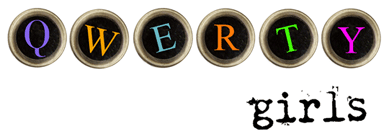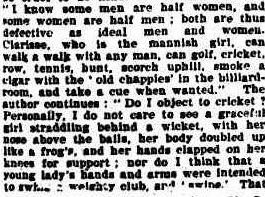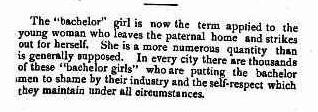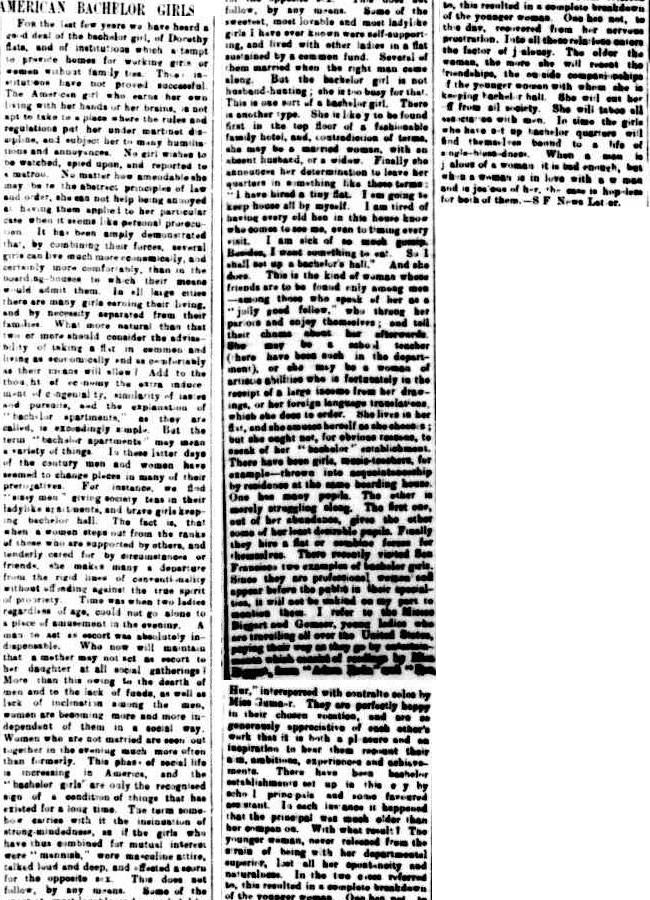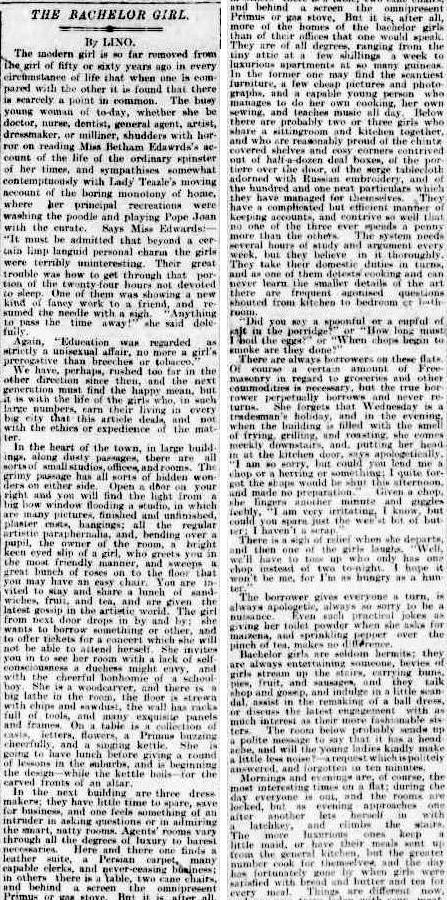Mannish women and bachelor girls: the women who chose a different path
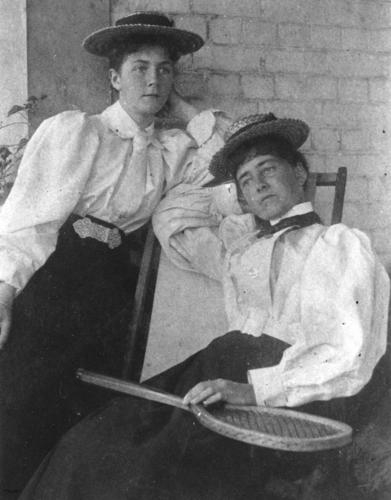
"The motion of tennis ruins the bust" according to one journalist in 1899.
The women in the picture about are ready for a game of tennis - seems harmless enough, doesn't it? But in the 1890s, even exercise for women was viewed with some suspicion from the more conservative Aussies.
The thing is: it didn't stop these women. They're clearly off to a game of tennis. Don't like it? You can lump it.
Lilian Cooper and Josephine Bedford lived a rich, remarkable life together: one that they would never have lived if they'd listen to the conservatives. But what exactly were they up against? What resistance was there to the change they symbolised?
And Lilian and Josephine were change.
- First, Lilian Cooper was a doctor at a time when there were only one other practicing female doctor in all of Australia.
- Second, Lilian and Josephine never married, but lived happily together until parted by death in their old age.
- Third, Josephine Bedford threw herself into social welfare tasks that many other Brisbanites would surely have found laughable, such as the humane transport of cows.
Did people think of Lilian and Josephine as spinsters or bachelor girls? Or worse, were they considered deviants? It's no leap for a woman like myself to make the leap to the belief that Lilian and Josephine were lovers, but did that ever cross the minds of their contemporaries? Or was lesbianism so invisible, it never even occurred to most people?
I know that my research is leading me to believe that Lilian and Josephine had a hellava lot of supporters, and that life in Brisbane in the 1890s was not as painful and isolated as many history books would have us believe. But let's look at some of the idiotic generalities that were the accepted truth of so many in the 1890s.
Spinsters: the ultimate threat
I could fill twenty websites with the number of articles I found that ridicule unmarried women. Most are designed to terrify women with the threat of spinsterhood. To be a spinster is, according to these articles, to be an object of ridicule and pity.
I have to ask - why? Why were spinsters such a threat to the status quo that newspapers across the world used the word 'spinster' as an insult to womanhood. Even now, the word 'spinster' is negative and insulting. Why did spinsters scare the stuffing out of men?
One has to admire Lilian and Josephine, then, to shrug off the perceived humiliation of living a life without a husband.
My pick of the stupid articles about spinsters is this one:
The Spinster's Numeration Table
This article is horrible, horrible, horrible. It's designed to chase twenty-something girls out of singledom and into marriage by making it very clear that there is a cut-off to sexuality. If they leave it too long, they'll end up 'epicene' (with both male and female characteristics). Even today, there's a belief that older women are not sexual beings, but I doubt we would put it as bluntly these days!
But what I find most interesting about it is its not-so-cloaked reference to lesbianism. Take a look at this quote from the article:
"Swears eternal friendship to a spinster friend, and keeps a cage of canary birds... Makes her will. Leaves all to her beloved Arabella, except an annuity to the cat and canary birds..."
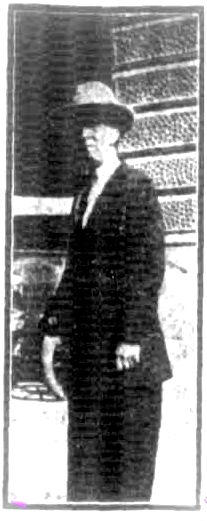
A wonderful photo I found of Lilian Cooper. [Sydney Evening News, 1923]
Masculine women are deviants
Let's not beat about the bush: Lilian Cooper was a masculine woman. I recently found this fantastic photo of her from the Sydney News, 1932. To all intents and purposes, she is dressed as a man. And even her younger photos show her in very masculine attire.
Masculine women were the ultimate no-no. Femininity was praised above all else. In fact, some writers even believed that masculine women were inclined to criminality.
Again, it is clear that Lilian did not attempt to conform to a rigid idea of femininity, which may have raised a few eyebrows among the more conservative sections of Brisbane society. However, as I've shown, it did not cut her out of society with the upper echelons of Brisbane's well-to-do.
'Mannish women' can damage their health
Exercise was a huge point of discussion in dozens of articles that I found. Cycling, in particular, was considered offensive. By the same token, cycling was clearly a huge passion among many women. (I can't help but feel that the number of articles against a particular activity is directly proportionate to the speed with which that activity is gaining acceptance! The conservatives seem to fight harder when they're losing a battle!)
Here's just one clipping from many articles I've found, taken from The Brisbane Courier, 1888.
I like this little clip particularly because of this statement:
"I know some men are half women and some women are half men."
Even though he then goes on to say that such people are 'defective', it shows that there was an awareness that some people did not conform. It gives a little visibility to those women. Again, I feel that they must have existed in some numbers for the writer to take such offence to them!
The revolution of the bachelor girls
But not every newspaper was screaming out their support for traditional female roles. In 1891, I found this reference to bachelor girls.
Clearly, 'bachelor girls' are women who chose not to marry, but to live independently. Strangely enough, in the newspapers there are bright spots of support for such a woman! But not always...
"When a woman is in love with a woman...it is hopeless for both of them"
This article above is taken from an American newspaper, and reprinted here in Australia in 1894. It's hard to read but worth the effort. It talks about how some women have taken to living together, or by themselves, in 'bachelor halls' (the equivalent of a bachelor pad).
The journalist tries to be sympathetic to the bachelor girls, but there is a word of warning for young girls setting up a home with an older woman:
"When a man is jealous of a woman it is bad enough, but when a woman is in love with a woman and is jealous of her, the case is hopeless for both of them."
This is one of the very few references I was able to find of a journalist directly saying that a woman could be 'in love' with a woman, and even though the journalist might be using the phrase to drive home a point, rather than to actually intimate that women can be in love, it's still an exciting find. It means that some people were aware that a close, exclusive relationship can exist between two women - even though this is clearly not a desired state! Two women in love will never be married! A fate worse than death!;)
As we creep through the 1890s, we find the phrase 'bachelor girls' cropping up with more frequency in the newspapers. Perhaps Lilian and Josephine surfed this wave of acceptance?
The following article is taken from a New York newspaper and reprinted in the Argus in 1900, 9 years after Lilian and Josephine first arrived in Australia. Although it's not an Australian article, I think it shows the growing visibility of women who choose a different path in life.
I can't forget, when I'm writing about these women, that when Lilian and Josephine opened the newspaper in the morning, they were confronted by ridiculous, conservative, backward articles about women. I think to myself...surely it would have saddened them, and made them feel ostracised.
But then I think...I'm also confronted by ridiculous articles about lesbians and gay marriage when I read the newspaper.
Maybe, Lilian and Josephine didn't let it get them down. Maybe, they just got good and angry. 😉
Delve into more Lilian Cooper research
